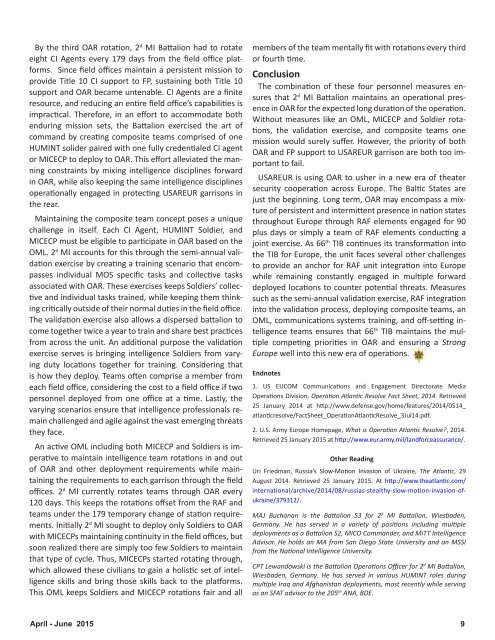incorrect
2015_02
2015_02
- No tags were found...
Create successful ePaper yourself
Turn your PDF publications into a flip-book with our unique Google optimized e-Paper software.
By the third OAR rotation, 2 d MI Battalion had to rotate<br />
eight CI Agents every 179 days from the field office platforms.<br />
Since field offices maintain a persistent mission to<br />
provide Title 10 CI support to FP, sustaining both Title 10<br />
support and OAR became untenable. CI Agents are a finite<br />
resource, and reducing an entire field office’s capabilities is<br />
impractical. Therefore, in an effort to accommodate both<br />
enduring mission sets, the Battalion exercised the art of<br />
command by creating composite teams comprised of one<br />
HUMINT solider paired with one fully credentialed CI agent<br />
or MICECP to deploy to OAR. This effort alleviated the manning<br />
constraints by mixing intelligence disciplines forward<br />
in OAR, while also keeping the same intelligence disciplines<br />
operationally engaged in protecting USAREUR garrisons in<br />
the rear.<br />
Maintaining the composite team concept poses a unique<br />
challenge in itself. Each CI Agent, HUMINT Soldier, and<br />
MICECP must be eligible to participate in OAR based on the<br />
OML. 2 d MI accounts for this through the semi-annual validation<br />
exercise by creating a training scenario that encompasses<br />
individual MOS specific tasks and collective tasks<br />
associated with OAR. These exercises keeps Soldiers’ collective<br />
and individual tasks trained, while keeping them thinking<br />
critically outside of their normal duties in the field office.<br />
The validation exercise also allows a dispersed battalion to<br />
come together twice a year to train and share best practices<br />
from across the unit. An additional purpose the validation<br />
exercise serves is bringing intelligence Soldiers from varying<br />
duty locations together for training. Considering that<br />
is how they deploy. Teams often comprise a member from<br />
each field office, considering the cost to a field office if two<br />
personnel deployed from one office at a time. Lastly, the<br />
varying scenarios ensure that intelligence professionals remain<br />
challenged and agile against the vast emerging threats<br />
they face.<br />
An active OML including both MICECP and Soldiers is imperative<br />
to maintain intelligence team rotations in and out<br />
of OAR and other deployment requirements while maintaining<br />
the requirements to each garrison through the field<br />
offices. 2 d MI currently rotates teams through OAR every<br />
120 days. This keeps the rotations offset from the RAF and<br />
teams under the 179 temporary change of station requirements.<br />
Initially 2 d MI sought to deploy only Soldiers to OAR<br />
with MICECPs maintaining continuity in the field offices, but<br />
soon realized there are simply too few Soldiers to maintain<br />
that type of cycle. Thus, MICECPs started rotating through,<br />
which allowed these civilians to gain a holistic set of intelligence<br />
skills and bring those skills back to the platforms.<br />
This OML keeps Soldiers and MICECP rotations fair and all<br />
members of the team mentally fit with rotations every third<br />
or fourth time.<br />
Conclusion<br />
The combination of these four personnel measures ensures<br />
that 2 d MI Battalion maintains an operational presence<br />
in OAR for the expected long duration of the operation.<br />
Without measures like an OML, MICECP and Soldier rotations,<br />
the validation exercise, and composite teams one<br />
mission would surely suffer. However, the priority of both<br />
OAR and FP support to USAREUR garrison are both too important<br />
to fail.<br />
USAREUR is using OAR to usher in a new era of theater<br />
security cooperation across Europe. The Baltic States are<br />
just the beginning. Long term, OAR may encompass a mixture<br />
of persistent and intermittent presence in nation states<br />
throughout Europe through RAF elements engaged for 90<br />
plus days or simply a team of RAF elements conducting a<br />
joint exercise. As 66 th TIB continues its transformation into<br />
the TIB for Europe, the unit faces several other challenges<br />
to provide an anchor for RAF unit integration into Europe<br />
while remaining constantly engaged in multiple forward<br />
deployed locations to counter potential threats. Measures<br />
such as the semi-annual validation exercise, RAF integration<br />
into the validation process, deploying composite teams, an<br />
OML, communications systems training, and off-setting intelligence<br />
teams ensures that 66 th TIB maintains the multiple<br />
competing priorities in OAR and ensuring a Strong<br />
Europe well into this new era of operations.<br />
Endnotes<br />
1. US EUCOM Communications and Engagement Directorate Media<br />
Operations Division, Operation Atlantic Resolve Fact Sheet, 2014. Retrieved<br />
25 January 2014 at http://www.defense.gov/home/features/2014/0514_<br />
atlanticresolve/FactSheet_OperationAtlanticResolve_3Jul14.pdf.<br />
2. U.S. Army Europe Homepage, What is Operation Atlantic Resolve?, 2014.<br />
Retrieved 25 January 2015 at http://www.eur.army.mil/landforceassurance/.<br />
Other Reading<br />
Uri Friedman, Russia’s Slow-Motion Invasion of Ukraine, The Atlantic, 29<br />
August 2014. Retrieved 25 January 2015. At http://www.theatlantic.com/<br />
international/archive/2014/08/russias-stealthy-slow-motion-invasion-ofukraine/379312/.<br />
MAJ Buchanan is the Battalion S3 for 2 d MI Battalion, Wiesbaden,<br />
Germany. He has served in a variety of positions including multiple<br />
deployments as a Battalion S2, MICO Commander, and MiTT Intelligence<br />
Advisor. He holds an MA from San Diego State University and an MSSI<br />
from the National Intelligence University.<br />
CPT Lewandowski is the Battalion Operations Officer for 2 d MI Battalion,<br />
Wiesbaden, Germany. He has served in various HUMINT roles during<br />
multiple Iraq and Afghanistan deployments, most recently while serving<br />
as an SFAT advisor to the 205 th ANA, BDE.<br />
April - June 2015<br />
9


